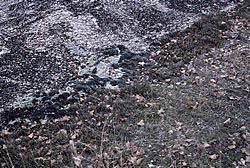







Modern lycophytes are low-growing understory plants, epiphytes, and submerged aquatics -- they are not a significant fraction of the modern vegetation. Their greatest diversity (as with virtually everything else) occurs in the wet tropics, though there are several alpine and subarctic species.
A number of species of Selaginella are known for their survival in extremely xeric conditions. These species occur in the dry, rocky regions of the southwestern United States where they cling to the sides of slopes and along the edges of outcrops, such as the one shown below in Llano County, Texas, near Austin. One species, Selaginella lepidophylla, is so tolerant of drying out that it has been dubbed the "resurrection plant", for it can recover from several months of complete drying. This is uncommon among vascular plants. Many tropical lycophytes experience xeric conditions as well. Those plants which live as epiphytes in the rainforest canopy are subject to intense light and drying winds.

Like ferns and other seedless vascular plants, lycophytes produce gametophyte plants which develop independently of their parent sporophyte. In the club mosses, the gametophyte is usually quite small, and may even develop underground. It relies on a mycorrhizal fungus to help provide nutrients and water. Some of these lycopodalean gametophytes may persist for 15 years before relasing their sperm or producing a sporophyte. Other lycophytes, such as Selaginella, have gametophytes which devlop entirely within the wall of the spore, never venturing out into the environment. These gametophytes may begin their sexual phase while still within the parent's sporangium, producing the new sporophyte generation from within the tissues of the previous sporophyte generation.


